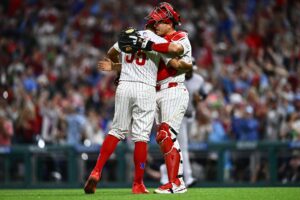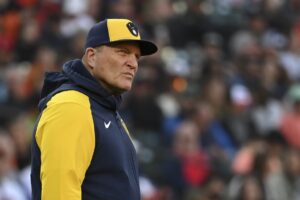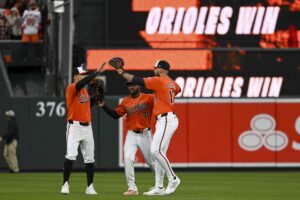This baseball season is going to be drastically different. That means the Atlanta Braves have a lot of questions to answer. Some of these are unconventional. The rise of COVID-19 has created a lot of problems that the team does not normally face. For instance, the DH in the National League, and who best fits that role. There are also the new medical testing rules, and how to deal with a situation where a key player tests positive.
Then, there are the regular, seasonal questions. Who will anchor the rotation? What kind of bullpen will show up? Will any of the new players, like Marcell Ozuna and Will Smith, make an impact? But, there is a question that might not seem as large in scope, yet could affect the team significantly: who plays third base? Johan Camargo and Austin Riley are both coming off subpar seasons. With Josh Donaldson’s departure, do the Braves put their faith in one of them, or will someone else rise to the occasion?
Atlanta Braves Third Base Preview
Johan Camargo
Camargo exploded onto the scene in 2017, with a .299 average and a 1.4 WAR in 82 games. His first full season in 2018 was just as solid: a .272 average, 19 homers, 76 RBI, 126 hits, and a 3.6 WAR in 134 games. But then came last season. After a slow start (.231 average in April, and an abysmal .186 in May), he roared to life in June. He hit .324 with a homer, nine RBI, and posted a .355 BAbip. However, his numbers dropped severely for the rest of the year, and he ended up with a .233 average, seven homers, 32 RBI, 54 hits, and 89 total bases. That’s probably why he was limited to 98 games last season.
A healthy Camargo could prove to be an excellent factor for Atlanta. His switch-hitting capabilities are not lost and could become valuable in a 60 game season. For his career, he’s batting .259 off right-handed pitching and .291 off left-handed pitching. He is also very reliable in a clutch situation, hitting .302 in 2-out, RISP situations. He also holds a .303 mark with 16 home runs when his team is losing the game. With Donaldson’s bat and glove no longer a part of the team, he will be called upon a lot more this season. He might platoon some with Dansby Swanson at shortstop, but he should primarily be used at third base. Braves fans should keep an eye on Camargo, as he might play well considering the odd nature of this season.
Austin Riley
A second option for third base is Austin Riley. Last season, Austin exploded onto the scene. He won National League Rookie of the Month in May after hitting .356 with seven homers, 20 RBI, 21 hits, a .746 slugging percentage, a 1.143 OPS, and a 201 tOPS+ in 15 games. But, as with Camargo, his numbers took a severe hit for the rest of the season. Injuries were part of the problem, but the league’s pitching also figured out that he doesn’t have a lot of patience. He walked 16 times in 274 at-bats while striking out 108 times. He went 17-109 (.156) over the last three months of the season and walked a mere eight times.
But Spring Training this season has led to some flashes of hope. Riley hit .357 in the shortened affair, with two homers, four RBI, 10 hits, a .643 slugging percentage, and a 1.080 OPS. True, the quality of pitching he was facing was only a 7.0. But he has shown signs of improvement. His two home runs in a recent exhibition game against the Miami Marlins are also an excellent sign. However, he only walked four times in 32 plate appearances during the spring, so it might behoove him to continue working on his patience.
The Matt Adams Signing
The third base situation has another twist with the addition of Matt Adams. While he is not a third baseman by trade, he can play in the outfield. Riley saw a lot of playing time outside the dirt last season (60 games, with a .958 fielding percentage and a 1.69 range factor per nine innings). He only made four starts at his primary position. Even though it was a small sample size, he showed significant defensive improvement. He did not commit an error at third base while committing four in the outfield. Since Adams has had experience in that position, Brian Snitker might call upon him for outfield duty more often. As a result, Riley can get more starts at third base.
Camargo himself is another outfield option, albeit a bit of a liable one. He’s only played 17 games of his career in the outfield. But he has also only committed one error in 114.2 innings and converted 26 putouts in 27 chances. As with Adams, it is a small sample size, but one that Snitker might take advantage of in order to give Riley more chances at third base. With the new DH rules in place, Camargo might also be utilized in that role. In short, the platoon between himself and Riley at third base should be such that neither of them will be underused.
Overall
The Braves third base situation is one that is at once intriguing, yet also highly irregular. For a team that, historically, has fielded very good third basemen (Chipper Jones, Eddie Mathews, Darrell Evans, etc.), this might be one of their weaker platoons. However, what makes the duo so dangerous is their potential for an explosive offense. The excitement in watching them play comes from knowing that, at any given moment, they could lock on.
With Adams, Ozuna, and others making the outfield truly tight, Camargo and Riley can each focus on third base. They could flourish this year if Camargo can stay healthy and Riley can retool his approach at the plate. They are unknown quantities. But sometimes, the most important pieces of an offense can come from the strangest of places.
Main Photo:
Embed from Getty Images






